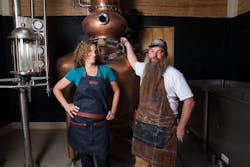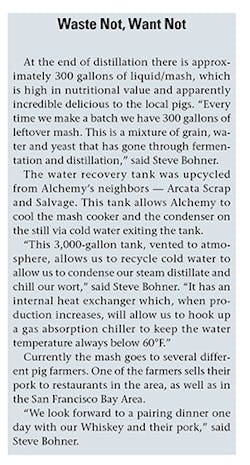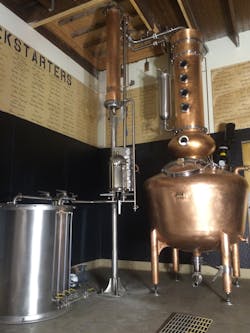Distillery dream becomes reality with hydronics experience
ARCATA, CALIF. — Just an hour-and-a-half south of the Oregon border, somewhere between where the redwood forests meet the Pacific Ocean, Amy and Steve Bohner — husband and wife entrepreneurs living in Northern California — started Alchemy Construction in 1998 with a focus on sustainable building practices.
One of Steve’s specialties is his mechanical rooms for radiant heating and solar systems. Installing boilers and process piping has become something of an art form with copper being the star of the room, not merely a way to move water.
In 2011, Steve and Amy decided to start a new adventure together. Sharing a love of small batch spirits and America’s signature whiskey, bourbon, the Bohners decided to open the first craft distillery in Arcata. Starting construction in May 2014, with a “live fire” in September 2015, with continuous upgrades and improvements along the way, Alchemy Distillery is a small batch craft distillery in and it "mills and distills" locally grown grains on site, exclusively with American-made equipment.
They began their research conducting extensive training at a distillery in Chicago.
On the trip, Amy arranged a private tour of Vendome Copper and Brass Works in Lexington, Kentucky. This is a 4th-generation manufacturer that fabricates stills for many American distilleries. Their craftsmanship and attention to detail is unparalleled in this country and they are one of the largest still manufacturers in the world.
During their tour, Amy and Steve decided not only would they be purchasing an American-made still from Vendome, but every piece of equipment would be made in the United States. This includes the boiler, still, cooker, three-compartment spirit tank, fermenter tanks, water filtrations system, roller mill, bottling machine, corker, labeling machine and even the bottles, corks and labels.
Upon returning home from bourbon country, the Bohners wrote a business plan, secured financing and started equipment layout and design.
Getting to work
Working a day job only allowed the Bohners to work in the distillery on evenings and weekends initially, so the pace was slow. “A project that might take a week if done full time took months due to the set up and take down every day. We learned to shift our thinking to seeing progress every day,” said Amy Bohner.
Their scope of work included assembling and installing distillery equipment, concrete work, electrical, plumbing, steam boiler installation, roof framing and venting. They noticed that every distillery required a boiler and a significant amount of process piping due to the heating and cooling during cooking, fermenting and distillation. This was a good sign since they had 18 years’ experience with such piping.
We had the advantages of owning the right tools and having decades of experience, but we also got to decide exactly how we wanted everything set up for maximum efficiency.
Installation of the mechanical room included a Hurst 10 HP steam boiler for process heating only. The domestic hot water and heating for the fermenters is from an HTP Phoenix Evolution modulating, condensing boiler — which combines space heating and domestic hot water in one unit — in the office, and supplies radiant heat in the office, as well. “We also have radiant tubing in our barrel room in case we want to experiment with heating and cooling the barrels in the future,” said Amy Bohner.
Although fairly similar in installation, “We don't typically use schedule 40 iron pipe in our radiant installations as we did in the distillery. We usually do exposed piping in our radiant systems, we also use a lot of Viega ProPress — they were just larger in size in this installation,” said Steve Bohner. “We use Taco pumps, Viega ProPress fittings and valves, and tekmar setpoints, thermostats and controls.”
We also used our experience with set point controls and low water temperatures in radiant installations to automate our fermentation process. Some distillers lamented not having hot water in the distillery, so we added this feature with hot water provided from the boiler in our office. Each fermenter has its own programmable set point thermostat to control heating and cooling.
“We specifically ordered jacketed fermenters allowing us to heat and cool via set point controls,” said Steve Bohner. “It should be noted that our domestic hot water and set point are at two different temperatures.”
A trench drain in the middle of the distillery with removable grate was used for ease of cleaning. The floor is pitched toward the trench drain, which helps with keeping the distillery clean and sterile. “It is something we noticed a lot of distilleries didn't have and they complained about it,” added Steve Bohner.
Building the distillery has been so rewarding, said the Bohners. “We had the advantages of owning the right tools and having decades of experience, but we also got to decide exactly how we wanted everything set up for maximum efficiency,” said Amy Bohner. “There is quite a bit of down time during distillation so we often find ourselves admiring the piping. It truly is a work of art. The walls were bare before the piping was complete, and now the piping is the star of the room, besides the still of course.
“Being able to say we really built our own distillery is quite an honor for us and we hope to help others with their distillery build outs in the future,” added Amy Bohner. “In fact, Steve recently spoke at the annual American Distilling Institute Conference in San Diego. The lecture was called ‘A Contractor's Guide to Building a Distillery.’ Several people have already contacted us for consulting.”


